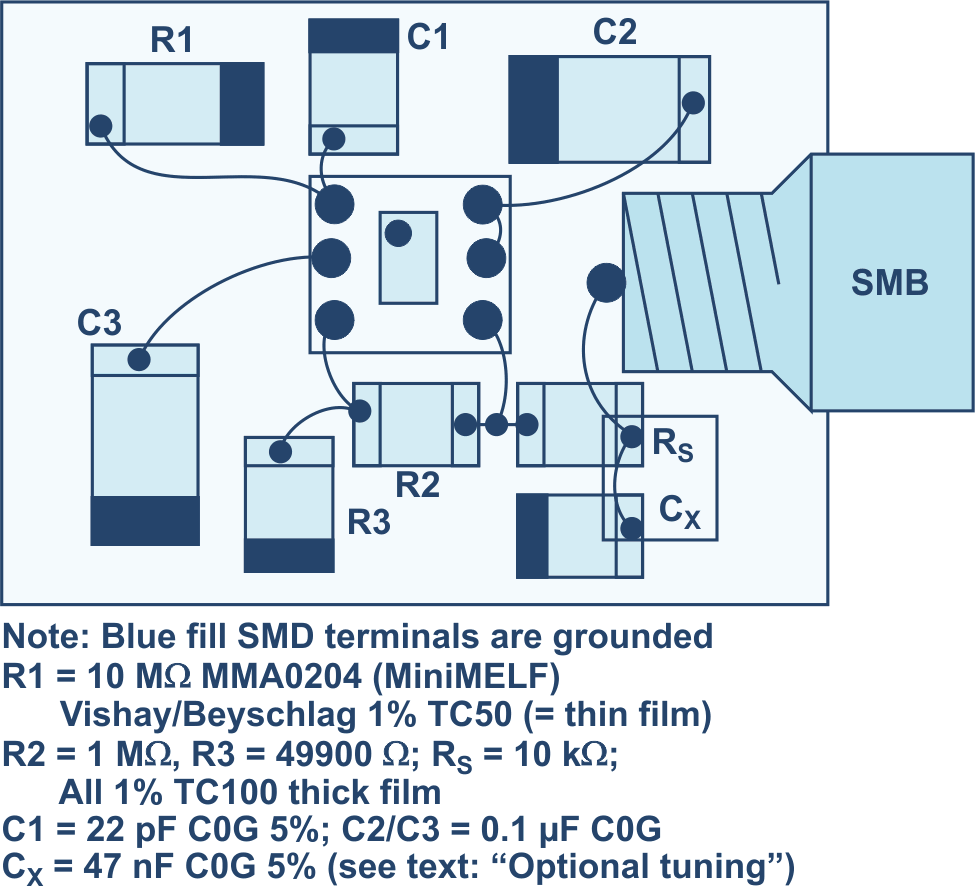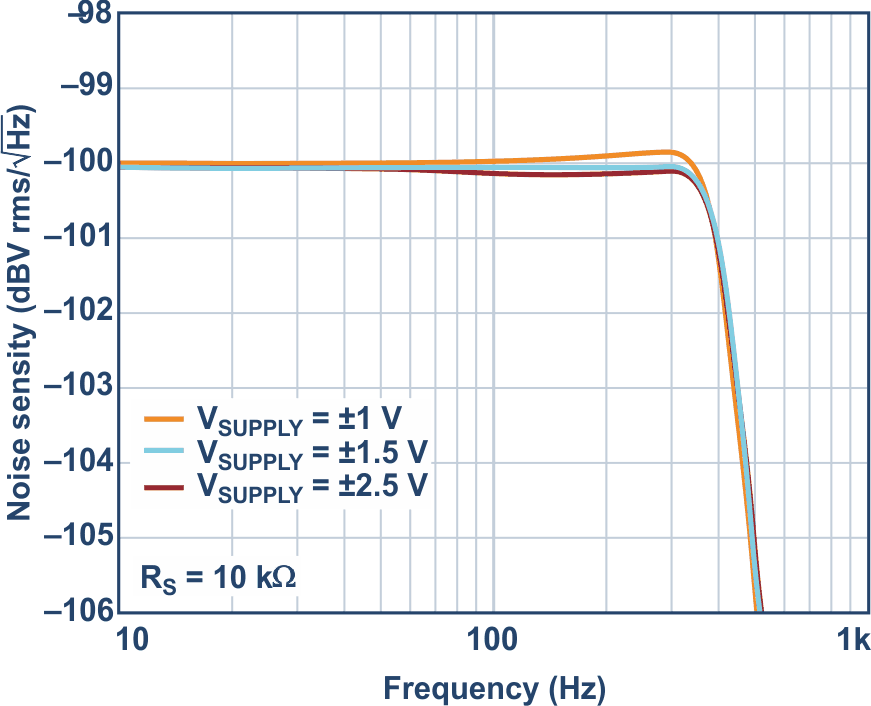Implementation details
Loop area R1/C1/R3 should be minimized for best EMI rejection (Figure 3). Additionally, R1/C1 should be very well shielded from electrical fields, which will be discussed further in the EMI Considerations section. Although not critical, R1 should be shielded from large temperature changes. With good EMI shielding, thermal shielding is often adequate.
 |
|
| Figure 3. | Gizmo layout. |
The LTC2063 rail-to-rail input voltage transition region of the VCM range should be avoided, as crossover may result in higher, less stable noise. For best results, use at least 1.1 V for V+ with the input at 0 common mode.
Note that RS of 10 kΩ may seem high, but the micropower LTC2063 presents a high output impedance; even 10 kΩ does not fully decouple the LTC2063 from load capacitance at its output. For this white noise generator circuit, some output capacitance that leads to peaking can be a design feature rather than a hazard.
The output sees 10 kΩ RS and a 50 nF CX to ground. This capacitor CX will interact with the LTC2063 circuit, resulting in some peaking in the frequency response. This peaking can be used to extend the flat bandwidth of the generator, in much the same way that port holes in loud speakers attempt to expand the low end. A high-Z load is assumed (>100 kΩ), as a lower-Z load would significantly reduce the output level, and may also affect peaking.
Optional tuning
Several IC parameters (for example, ROUT and GBW) affect flatness at the high frequency limit. Without access to a signal analyzer, the recommended value for CX is 47 nF, which typically yields 200 Hz to 300 Hz (–1 dB) bandwidth.
Nevertheless, CX can be optimized for either flatness or bandwidth, with CX = 30 nF to 50 nF typical. For wider bandwidth and more peaking, use a smaller CX. For a more damped response, use a larger CX.
Critical IC parameters are related to op amp supply current and parts with low supply current may require a somewhat larger CX, while parts with high supply current most likely require less than 30 nF while achieving wider flat bandwidth.
Plots shown here highlight how CX values affect closed-loop frequency response.
Measurements
Output noise density vs. CX (at RS = 10 kΩ, ±2.5 V supply) is reported in Figure 4. The output RC filter is effective in eliminating clock noise. The plot shows output vs. frequency for CX = 0 and CX = 2.2 nF/ 10 nF/ 47 nF/ 68 nF.
 |
|
| Figure 4. | Output noise density of design in Figure 1. |
CX = 2.2 nF exhibits mild peaking, while peaking is strongest for CX = 10 nF, gradually decreasing for larger CX. The trace for CX = 68 nF shows no peaking, but has visibly lower flat bandwidth. The best result is for CX ~ 47 nF; clock noise is three orders of magnitude below signal level. Due to limited vertical resolution, it is impossible to judge with fine precision the flatness of output amplitude vs. frequency. This plot was produced using ±2.5 V battery supply, though the design allows the use of two coin cells (about ±1.5 V).
Figure 5 shows flatness magnified on the Y-axis. For many applications, flatness within 1 dB is enough to be useful and <0.5 dB is exemplary. Here, CX = 50 nF is best (RS = 10 kΩ, VSUPPLY ±1.5 V), although CX = 45 nF … 55 nF is acceptable.
High resolution flatness measurements take time; for this plot (10 Hz to 1 kHz, 1000 averages), about 20 minutes per trace. The standard solution uses CX = 50 nF. The traces shown for 43 nF, 47 nF, and 56 nF, all Cs < 0.1% tolerance, show a small but visible deviation from best flatness. The orange trace for CX = 0 was added to show that peaking increases flat bandwidth (for ∆ = 0.5 dB, from 230 Hz to 380 Hz).
 |
|
| Figure 5. | Zoomed in view of output noise density of design in Figure 1. |
2 × 0.1 µF C0G in series is probably the simplest solution for an accurate 50 nF. 0.1 µF C0G 5% 1206 is easy to procure from Murata, TDK, and Kemet. Another option is a 47 nF C0G (1206 or 0805); this part is smaller, but may not be as commonly available. As stated prior, optimum CX varies with actual IC parameters.
Flatness was also checked vs. supply voltage; see Figure 6. The standard circuit is ±1.5 V. Changing supply voltage to ±1.0 V or ±2.5 V shows a small change in peaking as well as a small change in the flat level (due to VN changing vs. supply, with thermal noise dominant). Both peaking and flat level change ~0.2 dB over the full range of supply voltage. The plot suggests good amplitude stability and flatness when the circuit is powered from two small batteries.
 |
|
| Figure 6. | Output noise density for various supply voltages. |
For this prototype at ±1.5 V supply, flatness was within 0.5 dB up to approximately 380 Hz. At ±1.0 V supply, flat level and peaking slightly increase. For ±1.5 V to ±2.5 V supply voltage, the output level does not visibly change. Total V p-p (or V rms) output level depends on the fixed 10 µV/√Hz density, as well as on bandwidth. For this prototype, the output signal is ~1.5 mV p-p. At some very low frequency (mHz range), noise density may increase beyond the specified 10 µV/√Hz. For this prototype it was verified that at 0.1 Hz, noise density is still flat at 10 µV/√Hz.
In stability vs. temperature, thermal noise dominates, so for T = 22(±6) °C, the amplitude change is ±1%, a change that would barely be visible on a plot.
EMI considerations
The prototype uses a small copper foil with Kapton insulation as a shield. This foil, or flap, is wrapped around the input components (10 M + 22 pF), and soldered to ground on the PCB backside. Changing the position of the flap has significant effect on sensitivity to EMI and risk of low frequency (LF) spurs. Experimentation suggests that LF spurs that occasionally show are due to EMI, and that spurs can be prevented with very good shielding. With the flap, the prototype gives a clean response in the lab, without any additional mu-metal shielding. No mains noise or other spurs appear on a spectrum analyzer. If excess noise is visible on the signal, additional EMI shielding might be needed.
When an external power supply is used instead of batteries, common-mode current can easily add to the signal. It is recommended to connect the instrument grounds with a solid wire and use a CM choke in the supply wires to the generator.
Limitations
There are always applications that require more bandwidth, like full audio range or ultrasound range. More bandwidth is not realistic on a few µA of supply current. With approximately 300 Hz to 400 Hz of flat bandwidth, the LTC2063 resistor noise-based circuit could be useful to test some instruments for 50 Hz/60 Hz mains frequency, perhaps geophone applications. The range is suitable for testing various VLF applications (for example, sensor systems), as the frequency range extends down to <0.1 Hz.
The output signal level is low (<2 mV p-p). A follow-on LTC2063 configured as a noninverting amplifier with a gain of five and further RC output filter can provide a similarly well-controlled flat wideband noise output to 300 Hz with larger amplitude. In the case that does not maximize the closed-loop frequency range, a capacitor across the feedback resistor can lower the overall bandwidth. In this case, the effects of RS and CX will have less, or even negligible, effect at the edge of the closed-loop response.
Conclusion
The white noise generator described here is a small but essential tool. With long measurement times, the norm for LF applications – a simple, reliable, pocketable device that can produce near instantaneous circuit characterization – is a welcome addition to the engineer’s toolbox. Unlike complex instruments with numerous settings, this generator requires no user manual. This particular design features low supply current, essential for battery-powered operation in long duration VLF application measurements. When supply current is very low, there is no need for on/off switches. A generator that works on batteries also prevents common-mode currents.
The LTC2063 low power, zero-drift op amp used in this design is the key to meeting the constraints of the project. Its features enable use of a noise generating resistor gained up by a simple noninverting op amp circuit.